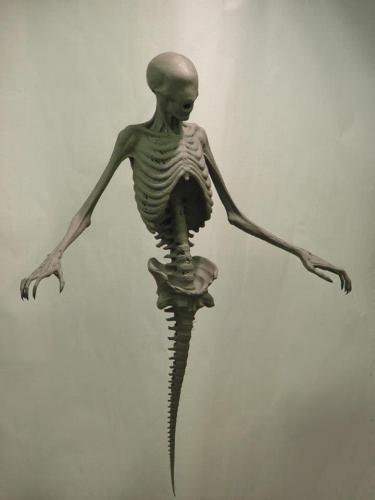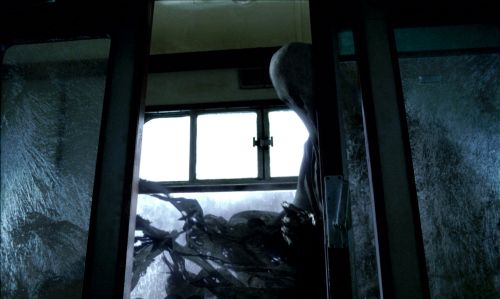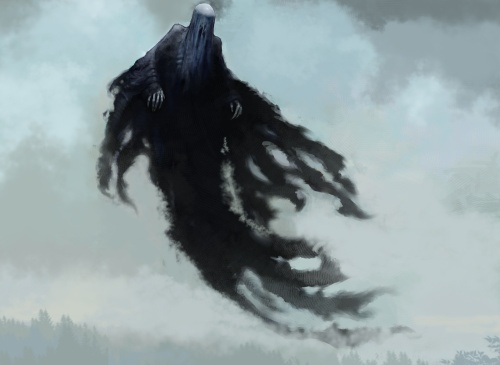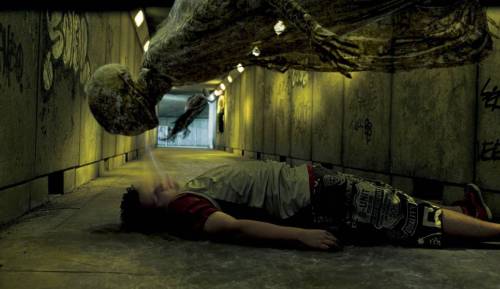Standing in the doorway, illuminated by the shivering flames in Lupin’s hand, was a cloaked figure that towered to the ceiling. Its face was completely hidden beneath its hood. Harry’s eyes darted downward, and what he saw made his stomach contract. There was a hand protruding from the cloak and it was glistening, grayish, slimy-looking, and scabbed, like something dead that had decayed in water…
But it was visible only for a split second. As though the creature beneath the cloak sensed Harry’s gaze, the hand was suddenly with-drawn into the folds of its black cloak.
-J.K. Rowling, Harry Potter and the Prisoner of Azkaban
When interviewed about Harry Potter and the Prisoner of Azkaban, J.K. Rowling was asked whether or not the Dementors were representative of depression. “That is exactly what they are,” her reply was. “It was entirely conscious. And entirely from my own experience. Depression is the most unpleasant thing I have ever experienced. It is that absence of being able to envisage that you will ever be cheerful again. The absence of hope. That very deadened feeling, which is so very different from feeling sad. Sad hurts but it’s a healthy feeling. It’s a necessary thing to feel. Depression is very different.” Rowling thus envisioned wraith-like figures that, with the ‘Dementor’s kiss’, drain people of their positive emotions and soul, leaving a living empty shell behind.
Where there should have been eyes, there was only thin, grey, scabbed skin, stretched blankly over empty sockets. But there was a mouth … a gaping, shapeless hole, sucking the air with the sound of a death-rattle.
In-keeping with the description from Harry Potter and the Prisoner of Azkaban, the film designers conceived the Dementors as ethereal characters whose skeletal anatomy would be veiled and suggested by black robes that hung from their heads. The only innovation director Alfonso Cuarón introduced was the ability of the Dementors to fly — enabling more creative freedom in the portrayal of their motion. Essentially, Cuarón wanted “something that was abstract and metaphysical.”
Rob Bliss was responsible for the final design of the Dementors. The concept art team envisioned the character as essentially a skeleton devoid of legs, with a spine ending in a pronounced tail section replacing the coccyx — all tightly wrapped in decaying skin. The head is featureless, with a gaping lamprey-like mouth — always in line with Rowling’s description. Since the Dementors would be filmed in mostly darkly-lit scenes, the colour scheme of their bodies and robes was endowed with dark gray and black tones, in order for them to blend in their surroundings but also remain the focus of the shots without disappearing completely. For the textures of both skin and robes, the crew referenced embalmed bodies, with rotting and loose wrappings. Working in collaboration with the costume department, the creature designer also experimented with various assortments of cloth and garments that would properly convey a floating motion. Once approved, Bliss’s design of the Dementors’ naked form was translated into three-dimensional maquettes, both in 1:3 scale and full size. The small-scale maquettes were sculpted by Bliss himself and Kate Hill, whereas the full-size maquette was sculpted by Chris Fitzgerald; the sculptures were cast in silicone.

 Cuarón’s initial idea was to bring the Dementors to life as rod puppets shot underwater to convincingly portray the floating motion of their robes. Dudman recalled. Intending to build and use full-size puppets, the team first tested the technique with third-scale puppets based on moulds of the maquettes and covered in fabric. For this purpose, underwater puppeteer Basil Twist was hired, based on his work on the Broadway show Symphonie Fantastique. Dudman recalled: “Basil Twist demonstrated moving fabric around on a stick, and we shot some film tests with our Dementor maquettes, blowing water around underwater to create waves and movement.”
Cuarón’s initial idea was to bring the Dementors to life as rod puppets shot underwater to convincingly portray the floating motion of their robes. Dudman recalled. Intending to build and use full-size puppets, the team first tested the technique with third-scale puppets based on moulds of the maquettes and covered in fabric. For this purpose, underwater puppeteer Basil Twist was hired, based on his work on the Broadway show Symphonie Fantastique. Dudman recalled: “Basil Twist demonstrated moving fabric around on a stick, and we shot some film tests with our Dementor maquettes, blowing water around underwater to create waves and movement.”
Slow-motion filming and reverse shooting were also experimented with. Ultimately, however, the technique proved unfeasible. Dudman continues: Every now and then, this produced some really wonderful effects; but, most of the time, it didn’t, because it was impossible to control. There was no way we could make the movements match a live-action plate. It became obvious that the only logical way to do this was CG.”
The task of creating the digital Dementors for the film was thus assigned to Industrial Light & Magic. The third-scale Dementor maquette served as scanning reference for the digital model, which was then manually enhanced. George explained: “our lead CG modeler, Michael Koper, built all of the skeletal detail. Digital artist Tom Fejes then covered it in fabric, and we kept it very dark. Alfonso steered us toward keeping the Dementors very mysterious and spectral.”
Although discarded, the underwater puppet tests served as reference for the CG team: Cuarón selected key moments from the tests that he thought captured the intended character of the Dementors. ILM had to replicate the effect of the tests in a digital and this time controllable form. The Dementors’ lack of facial connotations dictated that their animation had to rely on body language. ILM visual effects supervisor Bill George commented: “the Dementors were the chief bad guys of the film, but they had no eyes, no face, nothing to express emotion. It all came down to body posture and the way the faric moved. One of my goals was to get the cloth simulation guys — who usually strive to simulate reality — to be more creative in how they utilized their software, turning the model upside down, turning gravity off or running simulations backwards.” Glimpses of the Dementors’ anatomy would be revealed with animated wind sources pushing fabric into the rib cage. The model were not fitted with muscle systems but instead rigged with a single cloth-simulation mesh. The full-scale maquette provided by Dudman’s team served as on-set lighting reference.
The first appearance of a Dementor is during the train sequence early on in the film. ILM animation director David Andrews said: “Steve Rawlins created animation of the skeleton coming down the corridor. Cloth [simulation] lead Steve Sauers then moved a CG wind source coming up from underneath, blowing across the character to make the ‘tendrils’ rise. We shaped the tendrils by hand to make them more dynamic, bringing them up in frame then letting them fall back down. It took that kind of frame-by-frame handcrafting on top of the simulation to create the emotional effect we needed.”
The Dementor’s kiss was conveyed with a warping digital effect. George related: “Alfonso wanted a very subdued effect. Our first soul-suck tests were way over the top. Part of my job was to learn the more organic, subtle look that Alfonso wanted.” The final soul-draning effect was achieved with a combination of particle simulation, animated shapes with projected textures, and paint effects.
Visual effects supervisor Roger Guyett noted Cuarón’s deliberate downplayed focus on the creatures: “Alfonso wanted to underplay them in a natural way, without making a big spectacle of every effects shot. I’ve worked on movies where we’ve been asked to always see the creature as big as possible, and always in focus. But when we talked about adding more detail to the Dementors, for example, Alfonso insisted: ‘no, let’s just make it dark and shadowy. We don’t have to see every detail all the time.’ There’s a lot to be said for not having the effects jump out at you.”
The Dementors returned in an early sequence from Harry Potter and the Order of the Phoenix. They received an aesthetic makeover following the guidelines of director David Yates: the cloak was dialled back, thus exposing the creatures’ head and mouth and revealing more of their anatomy. Their tails were also lengthened to further highlight body language and movement.
Industrial Light & Magic developed new digital Dementors from scratch, having changed pipeline in the years following the production of Prisoner of Azkaban — going from B-spline modeling to subdivision modeling in Maya. The artists were able to reuse the original body design, but the cloth covering was completely revised. “Just like the Thestrals, the Dementors were built and animated in Maya,” explained Tim Alexander, visual effects supervisor. “The Dementors’ body was textured using displacement maps and paintwork, whereas the cape was created using many different displacement and opacity maps. We also added geometry to the edges of the cloth, so that rather than painting a frayed edge, we actually made a frayed edge. We hung little pieces of string off of the edge of the cloth, and ran a secondary simulation on those. It gave us an edge that was really tattered, while on Azkaban, we simply had opacity maps that we couldn’t use in a simulation.”
Animation of the Dementors had two layers: keyframe animation for the body and fabric simulation for the cloak. Compared to the Prisoner of Azkaban version, the cloth simulation was far more advanced, also because the animation had to satisfy Yates’ demands. Alexander related: “David wanted cloth tendrils to move like an octopus. When the Dementor reached out with his hand, he wanted the cloth to also reach out and grab hold of Harry.”
To that end, ILM devised a system of so-called spherical ‘attractors’ to control specific areas on the cloth. “Animators could guide the strips by telling attractors where they should go,” Alexander said. “When we ran the cloth simulation, it gave us an organic movement in which the strips would reach out to pre-designated points. It took a lot of fine-tuning to make it look natural, and not like the cloth was being pulled by the attractors.” Ironically enough, the new animation design was discarded in favour of a look closer to the original’s.
For Harry Potter and the Deathly Hallows Part II, creation of the Dementors was passed over to Rising Sun Pictures. The digital effects team developed a whole new creature rig with improved cloth simulation. Another innovation was the use of digital smoke to enhance their silhouette. “The Dementors were really just a black silhouette,” said Tony Clark, Rising Sun visual effects supervisor. “But you can get a lot of emotion from them even though they are just a head, two sticky arms and the flowing cloth that has a seaweedy underwater feeling. The original brief was for them to be inside the courtroom which was a very dark environment, so they were enveloped in smoke to read the silhouette.”
For more pictures of the Dementors, visit the Monster Galleries:












